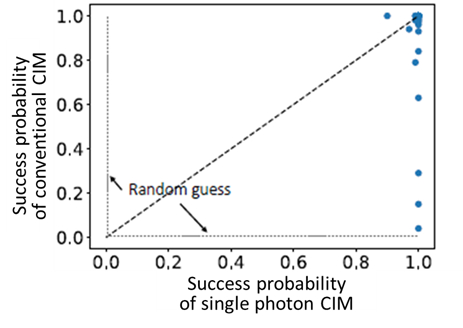News Highlights:
- Researchers at the NTT Research Physics and Informatics (PHI) Lab and Tohoku University co-author paper outlining the capabilities of single photon Coherent Ising Machines (CIM).
- Paper reports findings from a joint research initiative between the two organizations to bring to life large-scale cyber CIMs through high-performance computing.
- Single-photon CIM enables the conversion of fragile quantum entanglement into robust classical correlations between a measured pulse and all the other pulses.
NTT Research, Inc., a division of NTT (TYO:9432), announced that its Physics and Informatics (PHI) Lab and the Graduate School of Information Science(GSIS) at Tohoku University, jointly published the paper “Single photon coherent Ising machines for constrained optimization problems” in the Quantum Science and Technology journal. As part of the collaboration, researchers from the two institutions studied a combinatorial clustering problem which is a representative task in unsupervised machine learning.
This press release features multimedia. View the full release here: https://www.businesswire.com/news/home/20250709644790/en/

The success probabilities of the single photon and conventional CIMs are over 100 instances. The dashed line indicates the two success probabilities are equal. The success probabilities of the single photon CIM are superior to those of the conventional CIM with many photons per pulse.
Joint research agreement on large-scale cyber CIM with high-performance computing
Together, the two institutions are researching methods to bring to life a large-scale CIM simulation platform using conventional high-performance computing (HPC). This large-scale CIM will be critical to enabling cyber CIMs that will be widely accessible for solving hard NP, NP-complete and HP-hard problems.
The collaboration kicked off in 2023 with Hiroaki Kobayashi, Professor at the GSIS at Tohoku University, acting as the principal investigator for the joint research agreement (JRA), with PHI Lab Director Yoshihisa Yamamoto joining as the NTT Research counterpart to Kobayashi. As part of the JRA, Tohoku University will research methods to optimize the third-generation cyber CIM using HPC platforms. Following this research, Tohoku University will examine vectorization and parallelization of kernels as accelerants and consider optimization of data management in the cache memory hierarchy, as well as ways to scale cyber CIM to 100 million spins with sparse connection on an appropriate platform.
“NTT Research’s collaboration with GSIS at Tohoku University will unlock energy efficient and optimized machine learning accelerators,” said Yoshihisa Yamamoto, PHI Lab Director at NTT Research. “By combining quantum optical formalism and digital electronic platform, our work with Tohoku University brings us one step closer to bringing to life a large-scale CIM simulator, enabling cyber CIM simulators that offer users an accessible and efficient way to solve stochastic differential equations that describes a DOPO network with quantum measurement and feedback circuit.”
Critical to the JRA is the PHI Lab’s mission to use nonlinear quantum optical technologies to build simple, efficient and practical computing machines for real-world problems by redesigning analog/digital hybrid computers using the fundamental principles of quantum physics and neuroscience, drawing inspiration from biological computers present in brains. As part of this mission, the PHI Lab relies on the CIM, which is a network of degenerate optical parametric oscillators (DOPOs) programmed to solve combinatorial optimization problems mapped to an Ising model. The Ising model is a mathematical abstraction of magnetic systems composed of competitively interacting spins, or angular momenta of fundamental particles.
A striking result
In contrast to the conventional and experimental coherent Ising machines (CIM) reported previously in Science 354, 603 (2016) and Science 354, 614 (2016), a newly proposed CIM employs an average photon number per pulse as small as one, which is eight orders of magnitude smaller than the photon number existing in the conventional CIMs. In such an extremely weak light limit, performance of CIMs must be evaluated through quantum theory rather than classical heuristic models.
The result of a numerical simulation based on the quantum model was unexpected, which is in sharp contrast to a standard picture. Initially, it was hypothesized that a CIM with a single photon per pulse suffers from poor signal-to-noise ratio in the measurement of internal pulse amplitudes and challenges to storing the analog amplitude information stably. Under this assumption, the performance is expected to be much worse than the conventional CIM with 108 photons per pulse.
However, the research team found that within a numerical simulation, the result is the complete opposite. The graph shows the probabilities of success for finding exact solutions for various instances by single photon CIM and conventional CIM with 108 photons per pulse. The figure indicates the performance of the single photon CIM is much better than that of a conventional CIM.
Quantum enhancement mechanism
The superior performance of the single photon CIM discovered by the collaboration originates from a quantum mechanical effect. At a measurement port of the CIM, an extraction beam splitter generates a correlated internal pulse and extracted pulse to be measured, that is, the amplitude of the extracted pulse carries an information of the internal pulse amplitude. This correlation between the internal and extracted pulses penetrates into a quantum regime in spite of background noise which indicates the existence of quantum entanglement between these two pulses in the single photon CIM.
Despite the fragile nature of a quantum entanglement that can be easily destroyed by optical loss and background noise, the single photon CIM was able to convert the fragile quantum entanglement into robust classical correlations between a measured pulse and all the other pulses through its quantum measurement and feedback process. The generation of quantum entanglement and its immediate conversion to classical correlation is key for understanding the improved performance of the single photon CIM, which is absent in conventional CIMs that leverage many photons per pulse.
Looking ahead, NTT Research will continue to collaborate with GSIS at Tohoku University to move toward the physical implementation of the single-photon CIM, building on its theoretical validation and developing Cyber CIM, a large-scale simulation environment. This effort will pave the way for fast and energy-efficient solutions to real-world industrial problems.
About NTT Research
NTT Research opened its offices in July 2019 in Silicon Valley to conduct basic research and advance technologies as a foundational model for developing high-impact innovation across NTT Group’s global business. Currently, four groups are housed at NTT Research facilities in Sunnyvale: the Physics and Informatics (PHI) Lab, the Cryptography and Information Security (CIS) Lab, the Medical and Health Informatics (MEI) Lab, and the Physics of Artificial Intelligence (PAI) Group. The organization aims to advance science in four areas: 1) quantum information, neuroscience and photonics; 2) cryptographic and information security; 3) medical and health informatics; and 4) artificial intelligence. NTT Research is part of NTT, a global technology and business solutions provider with an annual R&D investment of thirty percent of its profits.
The names NTT and NTT Research, as well as the NTT and NTT Research logos, are trademarks and service marks of NIPPON TELEGRAPH AND TELEPHONE CORPORATION or NTT Research, Inc. and/or their affiliates. All other referenced product names are trademarks of their respective owners. © 2025 NTT Research, Inc.
View source version on businesswire.com: https://www.businesswire.com/news/home/20250709644790/en/
Contacts
NTT Research Contact:
Chris Shaw
Chief Marketing Officer
NTT Research
+1-312-888-5412
chris.shaw@ntt-research.com
Media Contact:
Nick Gibiser
Wireside Communications®
For NTT Research
+1-804-500-6660
ngibiser@wireside.com







